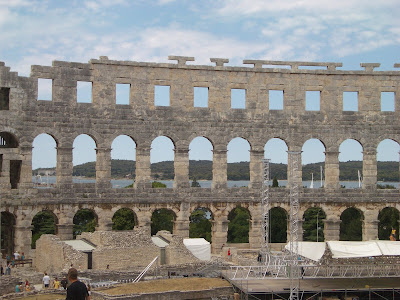 This the amphitheater you can see in Balasevic's video on Lina's post yesterday.
This the amphitheater you can see in Balasevic's video on Lina's post yesterday.On the southern part of the Istrian peninsula, at the end of the Gulf of Pula, a town of antiquity, of parks, and of summer festivals dominates. Pula (that has a similar history like Porec and Rovinj), is the largest city and port in Istria, a communication economic and administrative center and an attractive holiday place.
The history of the town is etched in every stone, which is indicated by the large number of cultural historic monuments from almost all periods of its past, of which many are an integral part of the fabric of the city.

The amphitheater is the only remaining Roman amphitheater to have four side towers and with all three Roman architectural orders entirely preserved. It is the sixth largest surviving Roman arena and a rare example, among the 200 Roman surviving amphitheatres, of unique technological solutions. It is also the best preserved ancient monument in Croatia.
The exterior wall is constructed in limestone.
The part facing the sea consists of three stories, while the other part has only two stories since the amphitheatre was built on a slope. The maximum height of the exterior wall is 29.40 m. The first two floors have each 72 arches, while the top floor consists of 64 rectangular openings.
The city's old quarter of narrow streets, lined with Medieval and Renaissance buildings, are still surfaced with ancient Roman paving stones.




.JPG)
.JPG)


1 comment:
uhauh ! Pula !
bellissima...
ke voglia di Croazia !!!
ma perchè non ho nessun parente da quelle parti che mi puo' ospitare !!!
mi sa che anche se ce l'avessi non mi ospiterebbe perchè non me ne andrei piu' !
Post a Comment